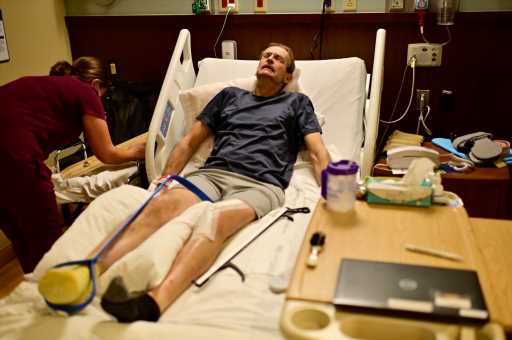Two cyclists battered and broken by hit-and-run drivers in one weekend
As Greg Johnson emerged from anesthesia following the first of three lengthy surgeries the avid cyclist would need because of injuries sustained when he was struck by a hit-and-run motorist on Father’s Day weekend, he overheard nurses discussing the case of another cyclist struck by a hit-and-run driver that same weekend.
“They were talking about me, and then the guy was talking about the other woman,” Johnson recalled in his room at St. Anthony Hospital in Lakewood last week. “The guy was pulling up something on his phone about the accident, showing the nurse who was taking care of me. I was in and out of consciousness, and the drugs were making me see spiders run across the ceiling, but that’s what they were talking about.”
Both cyclists were brought to St. Anthony Hospital because it’s a Level 1 trauma center — and neither will ever be the same.
Johnson, 64, suffered 21 broken bones including three broken vertebrae and a broken pelvis. His right femur was shattered into 40 pieces when he was struck on West 32nd Avenue, a few blocks west of Wheat Ridge, early on the morning of June 18. There’s a good chance he will never be able to ride again.
Lisa Ludwig, 61, of Evergreen, a member of the Team Evergreen cycling club, was struck shortly before 10 a.m. the next day while riding with a group of cyclists near Evergreen. She suffered a traumatic brain injury and multiple fractures, including three ribs, a shoulder blade and two vertebrae. She was unconscious for 19 days but awakened last week and was transferred to Craig Hospital for rehabilitation.
“She can say a few words,” Ludwig’s husband, Dave, said Friday. “She’s not always coherent. She can move her right arm and her left leg right now, and a little bit of her left arm and right leg. I’m hopeful that she’ll continue to recover.”
The two crashes, 27 hours apart, came as Colorado cycling advocates try to raise awareness about the increase in cycling deaths in recent years.
An average of 15 cyclists have been killed on Colorado roads annually over the past decade, according to Colorado Department of Transportation figures, as compared to nine per year the previous decade. The record of 22 was set in 2018, and there were 20 in 2019.
Cyclists feel threatened by distracted driving, ignorance of the state law that requires motorists to maintain three feet of separation between their vehicles and cyclists, and road rage on increasingly crowded Front Range roads.
In Ludwig’s case, witnesses told Jefferson County investigators that the person who hit her — and another rider, Mike Will — appeared to do so intentionally. Police issued an arrest warrant and took Haley Mill, 38, into custody four days later. Mill has since been charged with 11 counts, including first-degree assault, vehicular assault and leaving the scene of an accident. She is being held on $1 million bond.
“It was not an accident,” Dave Ludwig stressed. “It was hit-and-run. It’s really important not to call it an accident.”
Ludwig’s brain injury has been diagnosed as a diffuse axonal injury, which involves a shearing tear of nerve fibers (axons) in the brain.
“Lisa will never be Lisa again with severe DAI,” her husband said. The hit-and-run “took Lisa as we knew her from her loving husband, two children, family members and lots of great friends.”
The motorist who hit Johnson also left the scene — at a high rate of speed, according to Bob Shaver. A cyclist who was nearby and came to Johnson’s aid. So far, no arrests have been made in that case.
“While we did locate the vehicle the day of the crash and we do have a party as a person of interest, no charges have been filed or arrest made based on this case,” said Josh Lewis, a spokesman for the Colorado State Patrol, which is handling the investigation.
Johnson, an aerospace engineer for the Federal Aviation Administration, is an extremely dedicated cyclist. He has entered the grueling Mount Evans Hill Climb multiple times.
For 16 years in fair weather and foul, he routinely rode his bike to work from Wheat Ridge to Denver International Airport, which is 31 miles round-trip.
“I’ve probably driven out there a dozen times or less. I’ve always ridden my bike. It was kind of my mental challenge to do that year-round. I had 10-below (zero) as my cut-off for riding out there.”
Recovery, Johnson said, probably will require 12 to 24 months of physical therapy — and that’s before he’ll know whether he’ll ever be able to ride again.
“I’ll still consider myself a cyclist for that time period,” Johnson said. “It could have been much worse. I could have been dead. It took me a while to figure that out. I’m physically broken from the waist down. I’m not feeling normal, but I’m feeling the realization of what could have been. Very grateful to be here, lucky it didn’t have a worse outcome. I could have been paralyzed, in a wheelchair, pushing myself around.”
Johnson’s wife, Deb, said word of the crash first came in the form of a voice message informing her that Greg had a broken leg. She got an inkling things were much worse when she arrived at the hospital and was met by a nurse chaplain.
“I thought, ‘Oh, this doesn’t seem very good,’” she said. “My nieces came and tried to comfort me, but it’s been very, very hard to watch the suffering Greg has gone through.”
Johnson said there were times early in his hospital stay, while getting shifted to tables for MRIs, CAT scans and X-rays, when he screamed in pain.
“I was apologizing, but I was yelling,” Johnson said. “It was the most pain I’ve ever felt in my life.”
Johnson said there is no way the person who hit him can ever comprehend the pain and suffering he caused the couple, nor could he fathom what it would mean for a man like Johnson to be prevented from cycling.
“All I can hope is for due process,” Johnson said. “Whatever happens to that individual isn’t going to put me back to the way I was. I’m never going to be back to the way I was.”
If the situation had simply been an accident, a good person wouldn’t have left the scene, Johnson pointed out. “You stop and do whatever you can to render aid. You’ve made it wrong when you left and didn’t do what you should have done morally.”
Johnson hasn’t lost his sense of humor, though, which came out when he related what happened when he asked doctors if he will be able to return someday to fly fishing, his other passion.
“They said, ‘Absolutely, but you’re going to have a lot of time to tie flies before you get there.’”
Even if he can return to cycling, Johnson may never be able to ride a road bike because he now has two rods supporting his spine and that will prevent him from flexing his lower back.
“In a couple of years, I may be able to get back on a mountain bike, but it’s not 100% certain,” Johnson said, adding that he might take up kayaking some day for cardio fitness.
Things are even more uncertain for Lisa Ludwig.
“From my understanding, DAI is mild, moderate or severe,” Dave Ludwig said. “Lisa falls under the severe category. There was a very low chance of her even becoming conscious. Typically only around 10% of patients become conscious. The doctors really just don’t know, but with her becoming conscious, she’s already beaten the odds. I don’t think it will ever be 100%, but I’m hoping she will be able to walk and talk.
“If you’re a cyclist, the only advice I can give you is, make sure you have the very best helmet you can buy,” he continued. “And also get a living will in place, so your wishes can be obvious to whoever is taking care of you, if you ever get into a similar type of accident.”
Subscribe to our weekly newsletter, The Adventurist, to get outdoors news sent straight to your inbox.
Source: Read Full Article






